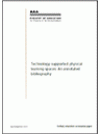This annotated bibliography reviews 225 papers on Tertiary Education Organisations’ (TEOs’) technology-supported physical learning spaces produced between 2005 and 2016 in New Zealand, Australia, Canada, the United Kingdom, and the United States.
Purpose
The objectives of this annotated bibliography are to assist TEO senior managers, teachers, Information Technology staff, and facilities staff, as well as government agencies, by identifying what worked and what did not in technology-supported physical learning spaces. The bibliography also provides an overview of the literature and extracts its important findings
Key Results
The key findings of this report are:
- Teachers and students need to be closely involved in the planning, design, and implementation of technology-supported physical learning spaces.
- The use of student devices enables informal spaces to support formal learning. These devices should interoperate with relevant TEO systems.
- Exemplars of technology-supported physical learning spaces are the SCALE-UP and TEAL[1] initiatives at North Carolina State University and Massachusetts Institute of Technology respectively.
- The major barriers to successful use of technology-supported physical learning spaces are a lack of teacher and student capability, insufficient training and support for teachers and students, and inappropriate pedagogical approaches from teachers.
- The major benefits of creating technology-supported physical learning spaces are more frequent and higher quality teacher-student and student-student interactions, increased student usage of, and satisfaction with, the learning space, and authentic learning experiences.

